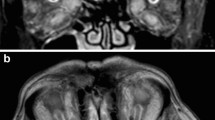Abstract
Purpose of Review
To review the epidemiology, classification, diagnosis, and management of open globe injuries.
Recent Findings
To date ocular injuries are a common cause of vision loss that can affect many age groups with serious socioeconomic impacts. Around 1.6 million people become blind from penetrating ocular trauma. Proper examination and intervention can lead to a better visual prognosis for the affected individuals. Here in, we review the classification of ocular trauma, the epidemiology, the diagnosis, and the management of open globe injuries based on their anatomic classification as well as their potential complications.
Summary
A high index of suspicion for an open globe, careful and gentle examination and early intervention may lead to better visual outcomes.





Similar content being viewed by others
References
Papers of particular interest, published recently, have been highlighted as: • Of importance
Schein OD, Hibberd PL, Shingleton BJ, et al. The spectrum and burden of ocular injury. Ophthalmology. 1988;95(3):300–5. https://doi.org/10.1016/S0161-6420(88)33183-0.
•Négrel AD, Thylefors B. The global impact of eye injuries. Ophthalmic Epidemiol. 1998 5(3):143–69. https://doi.org/10.1076/opep.5.3.143.8364. Ocular injuries are a common and preventable cause of vision loss whose impact of eye injuries and open globe is significant in global level
Kuhn F, Morris R, Witherspoon CD, Heimann K, Jeffers JB, Treister G. A standardized classification of ocular trauma. Ophthalmology. 1996;103(2):240–3. https://doi.org/10.1016/S0161-6420(96)30710-0.
•Pieramici DJ, Sternberg P Jr, Aaberg TM Sr, Bridges WZ Jr, Capone A Jr, Cardillo JA, de Juan E Jr, Kuhn F, Meredith TA, Mieler WF, Olsen TW, Rubsamen P, Stout T. A system for classifying mechanical injuries of the eye (globe). The ocular trauma classification group. Am J Ophthalmol. 1997 123(6):820–31. https://doi.org/10.1016/s0002-9394(14)71132-8. Understanding the mechanism of injury, defining the anatomy, and further classifying of open globe injuries can lead to efficient and proper management of the open globe and better visual prognosis
Ramirez DA, Porco TC, Lietman TM, Keenan JD. Ocular injury in united states emergency departments: seasonality and annual trends estimated from a nationally representative dataset. Am J Ophthalmol. 2018;191:149–55. https://doi.org/10.1016/j.ajo.2018.04.020.
May DR, Kuhn FP, Morris RE, Witherspoon CD, Danis RP, Matthews GP, Mann L. The epidemiology of serious eye injuries from the United States eye injury registry. Graefes Arch Clin Exp Ophthalmol. 2000;238(2):153–7. https://doi.org/10.1007/pl00007884.
Chronopoulos A, Ong JM, Thumann G, Schutz JS. Occult globe rupture: diagnostic and treatment challenge. Surv Ophthalmol. 2018;63(5):694–9. https://doi.org/10.1016/j.survophthal.2018.04.001.
Zeiter JH, Shin DH. Traumatic rupture of the globe after glaucoma surgery. Am J Ophthalmol. 1990;109(6):732–3. https://doi.org/10.1016/S0002-9394(14)72447-X.
Bali JL, Mcleod BK, Bali J. Traumatic wound dehiscence following cataract surgery: a thing of the past? Eye. 2001. https://doi.org/10.1038/eye.2001.11.
Vinger PF, Mieler WF, Oestreicher JH, Easterbrook M. Ruptured globes following radial and hexagonal keratotomy surgery. Arch Ophthalmol. 1996;114(2):129–34. https://doi.org/10.1001/archopht.1996.01100130123001.
Elder MJ, Stack RR. Globe rupture following penetrating keratoplasty: how often, why, and what can we do to prevent it? Cornea. 2004;23(8):776–80. https://doi.org/10.1097/01.ico.0000133996.99520.c4.
NeelakshiBhagat M, Tony Chen M, Marco A, Zarbin MP. Management of ocular trauma preventive measures and expedited treatment are critical. Retin Phys. 2020;17(2020):20–6.
Kuhn F, Pelayes DE. Management of the ruptured eye. Eur Ophthalmic Rev. 2009;03(01):48. https://doi.org/10.17925/EOR.2009.03.01.48.
Yuan WH, Hsu HC, Cheng HC, et al. CT of globe rupture: analysis and frequency of findings. Am J Roentgenol. 2014;202(5):1100–7. https://doi.org/10.2214/AJR.13.11010.
Wang D, Deobhakta A. Open globe injury: assessment and preoperative management. 2020.
Blanch RJ, Bishop J, Javidi H, Murray PI. Effect of time to primary repair on final visual outcome after open globe injury. Br J Ophthalmol. 2019;103(10):1491–4. https://doi.org/10.1136/bjophthalmol-2017-311559.
Pieramici D.J., Kah-Guan Au Eong, Sternberg P Jr, Marsh Marta. The prognostic significance of a system for classifying mechanical injuries of the eye (globe) in open-globe injuries. The Journal of TRAUMA Injury, Infection, and Critical Car. Published online April 2003:750–754.
•Kuhn F. The timing of reconstruction in severe mechanical trauma. Ophthalmic Res 2014 51(2):67–72. https://doi.org/10.1159/000351635. Proper intervention and management can lead to better visual prognosis
Loporchio D, Mukkamala L, Gorukanti K, Zarbin M, Langer P, Bhagat N. Intraocular foreign bodies: a review. Surv Ophthalmol. 2016;61(5):582–96. https://doi.org/10.1016/j.survophthal.2016.03.005.
Patel SN, Langer PD, Zarbin MA, Bhagat N. Diagnostic value of clinical examination and radiographic imaging in identification of intraocular foreign bodies in open globe injury. Eur J Ophthalmol. 2012;22(2):259–68. https://doi.org/10.5301/EJO.2011.8347.
John DA. Management of intraocular foreign bodies. In: Moroi SE, editor. EyeNet Magazine American Academy of Ophthalmology; 2009.
Ahmed Y, Schimel AM, Pathengay A, Colyer MH, Flynn HW. Endophthalmitis following open-globe injuries. Eye. 2012;26:212–7. https://doi.org/10.1038/eye.2011.313.
Funding
No funding was received for this manuscript.
Author information
Authors and Affiliations
Corresponding author
Ethics declarations
Conflict of interest
Dr. Eleni K. Konstantinou has nothing to disclose. Dr. Caroline R. Baumal has nothing to disclose relative to the manuscript.
Research involving Human and Animal Participants
No animal or human subjects by the authors were used in this study.
Additional information
Publisher's Note
Springer Nature remains neutral with regard to jurisdictional claims in published maps and institutional affiliations.
This article is part of the Topical collection on Ophthalmologic Surgery.
Rights and permissions
About this article
Cite this article
Konstantinou, E.K., Baumal, C.R. Open Globe Injuries. Curr Surg Rep 10, 103–108 (2022). https://doi.org/10.1007/s40137-022-00317-w
Accepted:
Published:
Issue Date:
DOI: https://doi.org/10.1007/s40137-022-00317-w




